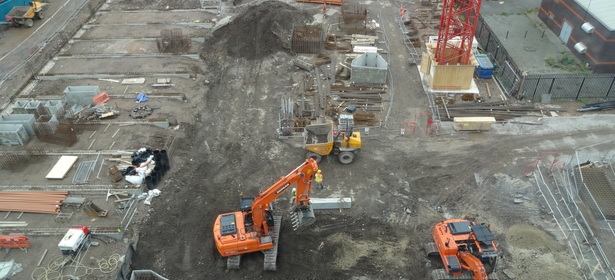Building the Future
Date published: 11 September 2013

Graham Wilson from the Chamber’s Property and Construction Committee outlines the latest developments in Building Regulations
Graham Wilson from the Chamber’s Property and Construction Committee outlines the latest developments in Building Regulations:
Those hoping for details of the forthcoming 2013 Building Regulations will be disappointed to hear that it will now be April 2014 before the changes are rolled out. The explanation from the Department of Energy & Climate Change (DECC) appears to be that it is ‘better to be late and get it right first time’. However, the regulations are a departure from the programme of carbon reductions set out in their 2006 and 2010 incarnations and do not follow the conclusions of the consultation phase, leaving many in the construction industry wondering if the roadmap for our low carbon future is soon to change.
During the consultation phase an 8% or no carbon reduction at all was largely supported by home builders, whilst a target of 26% or more was supported by the wider industry and green groups, citing the 2016 ‘zero carbon homes’ target. The 6% reduction now being implemented is a commercially motivated measure to keep the housing market moving in the short term. Also highlighted is the short sightedness of some within the industry, reflected in support for the 'do nothing' option. Surely by now we are all aware that doing nothing is not an option!
The picture is similar in the 11% and 20% carbon reductions put forward for consultation for non-domestic buildings. A 9% reduction has now been selected on the basis that this is achievable via fabric and fixed services performance only, with no requirement for renewables. Whilst this will keep development costs down it does little to support the renewables industry or to drive innovation in design.
The impact assessment estimates an additional cost of £453 per average new home and a 0.2% to 1.2% increase in commercial build costs over the 2010 regulations. Clearly, the Government is keen to avoid any risk of stifling any green shoots of recovery in the construction industry.
Despite lowering the bar in terms of design progression, the Government did reaffirm its commitment to 'zero carbon' new builds by 2016 for domestic and 2019 for non-domestic builds. This seems unlikely to be achievable, at least by the current definition of 'zero carbon', unless we compensate for the reduced 2014 targets in future regulations. Given that the next regulations would be due in 2016, how could the leap to ‘zero carbon’ domestic new builds still be achievable?
The impact assessment also makes reference to the Government’s long standing energy generation target of 15% renewables by 2020. Again, this is not encouraged by the new regulations. The impact assessment concedes that the new carbon targets are likely to be achievable without significant requirement for renewables. Instead, the Government is to rely on the likes of the Green Deal to maintain a renewable energy industry already suffering from the reduced scope of the FIT and RHI schemes. Take-up of the Green Deal has been slow and last week a large social housing organisation publically stated that they would not pursue Green Deal funding as they do not feel confident in the guarantees regarding energy and cost savings.
The impact assessment identifies current market failures, already widely acknowledged within the industry, surrounding lack of education amongst consumers, end users, tenants and landlords. ‘Part L’ is highlighted as a regulatory means to enforce improved performance, yet this is not borne out in the new changes. Instead, the Government cites reliance on commercial drivers such as the Code for Sustainable Homes and BREEAM to instigate voluntary higher performance. It is known that these voluntary drivers are not producing the required carbon reductions, leaving regulatory driven change as the only viable means for ensuring the required long term carbon targets are achieved.
Some other key points to note for 2014 are:
Changes to the non-domestic building services compliance guide promised but currently there are no details on what these will be.
No increase in consequential improvements is included due to fear that this would put people off building and stifle market recovery.
There will be no regulatory quality assurance to ensure performance meets design. This was removed due to anticipated burden on developers.
Whilst new minimum U-values are not currently included, the impact assessment includes packages of anticipated Notional Building U-values, all of which represent an improvement over 2010 standards. The U-value ranges are detailed below:
Roof - 0.10 – 0.18 W/m2K
External Wall - 0.20 – 0.26 W/m2K
Floor - 0.15 – 0.22 W/m2K
Window - 1.40 – 1.80 W/m2K
The lack of regulatory change and the reliance on undervalued voluntary carbon targets will cause damage to the renewables market and remove drivers for innovative building design. The statement that ‘Part L’ could be revisited if current market drivers (such as rising fuel prices and consumer awareness) fail does not fit the reality of the current commercial climate. The Government has acknowledged that these drivers are already failing and has compromised their long term carbon roadmap for the benefit of short term market recovery.
Graham Wilson of Parker Wilson Consulting and member of the Chamber’s Property & Construction Committee.
Do you have a story for us?
Let us know by emailing news@rochdaleonline.co.uk
All contact will be treated in confidence.
Most Viewed News Stories
- 1Man killed in M62 crash after car hits bridge at junction 19
- 2Abandoned shopping centre to be brought back to life as a banqueting hall
- 3GMP detain carjacker minutes after committing burglary in Rochdale
- 4The land has laid dormant for years, now £15m could help see it transformed
- 5How much council tax will go up in the Rochdale borough for each household
To contact the Rochdale Online news desk, email news@rochdaleonline.co.uk or visit our news submission page.
To get the latest news on your desktop or mobile, follow Rochdale Online on Twitter and Facebook.


